When disaster strikes, the Federal Emergency Management Agency (FEMA) is often the first line of defense, providing critical support and resources to affected communities. However, despite its best efforts, FEMA can be limited in its ability to respond quickly and effectively, particularly in remote or hard-to-reach areas. This is where artificial intelligence (AI) comes in, offering a potential solution to improve disaster response and relief efforts. AI-powered systems can analyze vast amounts of data, including satellite imagery, social media posts, and sensor readings, to quickly identify areas of need and prioritize response efforts. For example, AI can be used to detect damage to infrastructure, such as roads and bridges, and identify areas where people may be trapped or in need of assistance. Additionally, AI-powered chatbots can be used to provide critical information and support to affected individuals, helping to reduce the workload of emergency responders and improve response times. Furthermore, AI can be used to predict and prevent disasters, such as hurricanes and wildfires, by analyzing weather patterns and other environmental factors. This can help emergency responders to prepare and respond more effectively, reducing the risk of injury and loss of life. Moreover, AI can be used to improve the allocation of resources, such as food, water, and shelter, to ensure that those in need receive the support they require. In addition, AI-powered systems can be used to monitor and track the spread of diseases, helping to prevent outbreaks and reduce the risk of infection. The use of AI in disaster response is not without its challenges, however, including the need for high-quality data and the potential for bias in AI decision-making. Nevertheless, the potential benefits of AI in disaster response are significant, and it is an area that is being explored by researchers and emergency responders around the world. As the use of AI in disaster response continues to evolve, it is likely that we will see significant improvements in the speed and effectiveness of response efforts, ultimately saving lives and reducing the impact of disasters. The integration of AI into disaster response efforts is a complex task, requiring the collaboration of multiple stakeholders, including emergency responders, researchers, and policymakers. However, the potential rewards are significant, and it is an area that is worth exploring further. In conclusion, AI has the potential to revolutionize disaster response and relief efforts, providing a more effective and efficient solution to traditional methods. By leveraging the power of AI, emergency responders can respond more quickly and effectively, reducing the risk of injury and loss of life, and improving outcomes for affected communities.
